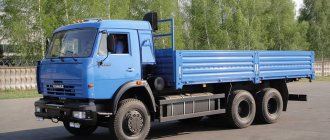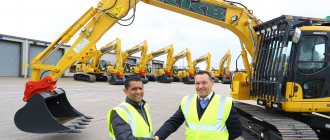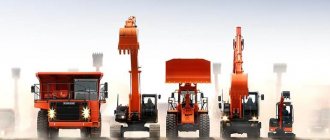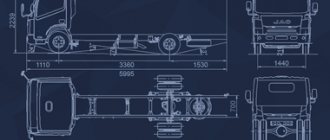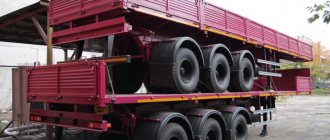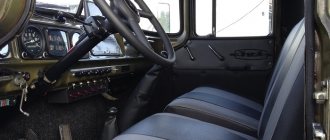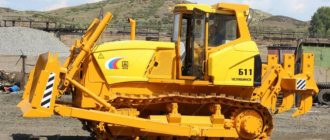ATs-3.2-40/4(43253) model 001-MS (hereinafter referred to as the tank truck) is designed to extinguish fires in residential buildings, structures, industrial facilities, deliver combat crews, fire-technical equipment, emergency rescue equipment to the place of call equipment and a supply of fire extinguishing agents.
Fire tanker ATs-3.2-40-4 on KamAZ 43253 4x2 chassis
A tank truck can be used as an independent combat unit, as well as as a pumping unit when working “in pumping” with one or more other tank trucks.
The tank truck design provides:
- filling the tank and foam tank with fire extinguishing agents;
- supply of water and foam from the tank through manual and stationary monitors without installation at a water source;
- water intake from a reservoir, fire hydrant and its supply for fire extinguishing needs through manual or stationary fire monitors;
- taking foam concentrate from a third-party container; – filling the tank with water under pressure from a third-party source through a dry pipe;
- placement in the body of the necessary fire-fighting weapons and equipment.
The tanker corresponds to climatic modification U (operation at air temperatures from –40 to +40°C), placement category 1 (for operation in the open air), operation in an atmosphere of types 1 and 2 (conditionally clean and industrial) according to GOST 15150 with placement in operational waiting period in a room with an air temperature not lower than +5°C
Reliable fire-fighting equipment from LLC “Center for Fire-Fighting Services”
The Fire Services Center LLC developed a special fire tanker (fire truck ATs-3.2-40) based on composite materials and launched its production for the 25th anniversary of the Russian Ministry of Emergency Situations, which in its characteristics is far ahead of similar vehicles on the market.
- Detailed technical specifications and documentation for this fire truck can be found here (PDF).
New cars
The basis was the load capacity of the chassis and the parametric data of the cars themselves. The use of the wheel formula as a determining factor in the vehicle's cross-country ability and the specific power of the vehicle depend on the first point. The parametric data of the machine determine the tactical, operational, design and technological features of this type of equipment. The key points when developing a PA are:
- water tank volume;
- foam tank volume;
- powder tank capacity;
- capacity of the fire extinguishing gas tank;
- pump performance;
- consumption of monitors;
- electric generator power;
- length of sleeve lines;
- boom lift height;
- number of combat crew seats;
- possibility of equipping with additional security systems.
In the early 2000s, the concept of the type of new fire trucks was adopted, which limited the number of basic models and placed an emphasis on modifications with expanded functionality. The developers were given the following tasks:
- modernization of the PAs currently in service with the Ministry of Emergency Situations;
- creation of new car models;
- development of fire trailers with superstructures, thanks to which the tactical capabilities of the main vehicle were expanded;
- modernization of base chassis.
Separately, machine builders received an order to create new fire trucks for specific operating conditions. The primary task was equipment for the northern regions, for extinguishing large fires, and the creation of an environmental protection complex.
Every year the basis for the implementation of the adopted concept changed. In 2005, the block-modular principle of PA design was taken as a basis. The result was the emergence of new special fire trucks, but a year after the reorganization of the State Fire Service, the issue of complete modernization of the vehicle fleet became acute. Vehicles differentiated by class have become relevant: light, medium and heavy. An analysis of the structure of the fire protection system abroad showed the need to equip fire fighters with personal protective equipment for personnel, devices for monitoring the environment and conducting reconnaissance, and primary means of localizing fires in order to prevent disasters.
According to statistics, in the early 2000s, the fire service's need for general-purpose PA was 75%. Of these, tank trucks were in first place (85%).
In recent years, there has been clear progress in the production of fire fighting equipment. The number of innovative solutions is growing, and fundamentally new machines are appearing. Three companies have become leaders in the production of chassis for the latest fire fighting vehicles: IVECO-AMT, URAL and KAMAZ, and all this is new generation equipment. At the same time, the price of the cars remains an order of magnitude lower compared to similar foreign-made models. During the manufacturing process, emphasis is placed on improving the design and safety of the PA. The design of the superstructures was redesigned and corrosion-resistant materials were used. Innovative technologies were also used in the design of fire extinguishing installations.
This is interesting: Fire truck PMG-1: history, design and performance characteristics
Basic cost 10,200,000 rubles.
For more information, use the feedback form or call: 8 (498) 540-35-35;;
Unfortunately, fires do happen, and they bring with them considerable losses, and sometimes even casualties. Firefighting equipment arriving on time to a call can save property and lives. Firefighting Services Center LLC produces custom-made modern fire engines that are reliable and have a long service life. If you want to buy special fire equipment in Moscow, then contact us.
Declaration of conformity Decision on the application for registration of a declaration of conformity
New equipment
Most of the vehicles in service with the GPS use traditional extinguishing agents: water, foam, powder, or work according to a combinatorial scheme. Some companies are developing innovative installations that make it possible to generate compression foam. These are the Natisk systems, CAFS with its variations, Hiromax. One of the leaders in this direction is considered to be from Yekaterinburg. The company has 10 vehicles equipped with the Na-Tisk system, which is a modified CAFS.
Thanks to modernization, the use of cars in the northern regions has become possible. Controlled samples showed that the efficiency of water consumption there increased by 7 times. The system operates even at temperatures of -60°C. Compression foam is supplied through Na-Tisk to a height of up to 200 m. Experiments have confirmed that the foam lasts up to 1.5 hours on wooden surfaces and up to 1 hour on metal surfaces.
The firefighters themselves appreciated the new system. They note that sleeves filled with compression foam are several times lighter than those that work with water. This increases maneuverability when extinguishing fires and reduces physical stress on fighters.
The latest firefighting equipment: Fire truck ATs-3.2-40
Reinforced composite is an innovative material for the manufacture of body elements of a fire truck. Unique physical and chemical properties of products made from it:
- 100% no corrosion;
- Fire resistant characteristics;
- Impact resistance and high strength of the material;
- Significant weight loss;
- Thermal stability and thermal insulation;
- Noise and vibration insulation;
- Easy to repair and operate.
The equipment of vehicles with fire-technical weapons and equipment is determined by agreement
with the customer) Phone numbers for ordering: Moscow branch: 8(903)7997411; 8(495)326-01-01;;; Kaluga branch.
Fire tanker ATs-3.2-40 (43253) on the KamAZ-43253 chassis. Specifications
| KamAZ-43253 (4×2) | |
| engine's type | diesel |
| Engine power kW, (hp) | 180 (245) |
| Maximum driving speed with full load, km/h | 95 |
| Number of seats for combat crew (including driver’s seat), people. | 5+1 |
| Water tank capacity, l | 3200 |
| Capacity of the foam concentrate tank, l | 200 |
| Fire pump | PN-40-UVM |
| Pump location | rear |
| Pump performance in nominal mode, hp | 40 |
| Pressure created by the fire pump in nominal mode, m | 100 |
| Diameter of suction pipe, mm | 125 |
| Diameter/number of pressure pipes, mm/pcs. | 80/2 |
| Total weight, kg | 14530 |
| Overall dimensions, mm | 7440x2530x3500 |
Equipment
| 4* | ||
| Reserve cylinder for DASV | 4* | |
| Dielectric kit (bag, carpet 750x750, latex gloves, boots, scissors) | 1 | |
| Heat-reflective suit TOK-200 | 3 | |
| TASK costume | 3* | |
| Safety glasses type ZP | 2 | |
| Rescue blanket (isothermal) | 2 | |
| Rubber boots (pair) | 5* | |
| Self-rescuer with a protective action time of at least 20 minutes. | 2 | |
| 2. Communications and navigation | ||
| Glonass navigation system | 1 | |
| Device for supplying special sound and light signals | 1 | |
| Portable radio | 4* | |
| Backup battery for portable radio station with charger, pcs. | 4* | |
| 3. Firefighting weapons | ||
| Water collector VS-125 | 1 | |
| GPS generator "Purga-5" | 2 | |
| Fire extinguishing aerosol generator type AGS-5 | 3 | |
| Hydraulic elevator G-600 | 1 | |
| Connecting heads: | ||
| -GP 70x50 or equivalent | 3 | |
| -GP 80x50 or equivalent | 3 | |
| -GP 80x70 or equivalent | 3 | |
| Sleeve delay | 4 | |
| Clamp 80 | 4 | |
| Key 80 | 2 | |
| Key 125 | 2 | |
| Column CP | 1 | |
| Columnist's tool | 1 | |
| Hook for opening the hydrant cover | 1 | |
| Hose bridge | 2 | |
| Fire extinguisher OP-5 | 1 | |
| Fire extinguisher OP-10 | 2 | |
| Fire extinguisher OU-5 | 1 | |
| Branch RT 70 | 2 | |
| Branch RT 80 | 2 | |
| Pressure hose with connecting fittings: | ||
| — DN 51, length 20 m | 6 | |
| — DN 66, length 20 m | 4 | |
| — DN 77, length 4 m | 2 | |
| — DN 77, length 20 m | 8 | |
| 4 m long hose with head KShch-1-32-3 | 1 | |
| Suction hose 4 m long with GDV-125 “V-1-125” | 2 | |
| Suction-pressure hose 4 m long with GDV-80 “V-2-75-10” | 2 | |
| Mesh with polyamide rope 11 mm in diameter, 12 m long SV-125 | 1 | |
| Hand barrels: | ||
| — universal, combined with variable flow rate Dу50 | 2 | |
| — combined shut-off valve with automatic flow rate Dу50 | 2 | |
| — combined overlap Dу70 | 2 | |
| Barrel for extinguishing peat fires | 2 | |
| 4. Rescue equipment | ||
| Fire rescue rope 30 m long in a case VPS-30 | 1 | |
| Fire rescue rope 50 m long in a case VPS-50 | 1 | |
| Ladder L-3K | 1 | |
| Ladder LP | 1 | |
| Ladder LSH | 1 | |
| 5. Rescue tool | ||
| 5.1. Hand-held non-motorized tool | ||
| All-metal gaff | 1 | |
| KP hook | 1 | |
| Sledgehammer with fiberglass handle weighing 5 kg | 1 | |
| Light scrap LPL | 1 | |
| Heavy scrap LPT | 1 | |
| Ball head crowbar | 1 | |
| Scrap universal health care facility | 1 | |
| Bayonet shovel | 1 | |
| Shovel | 1 | |
| Knife (cutter) for seat belts | 1 | |
| Carpenter's saw | 1 | |
| Ax with fiberglass handle type A2 | 1 | |
| Fireman's assault ax | 1 | |
| 5.2. Hand powered tools | ||
| Manual hydraulic jack | 1 | |
| Hand pump with hoses of at least 5 m Combined scissors | 1 | |
| 1 | ||
| Hand scissors for cutting metal | 1 | |
| Expander | 1 | |
| Wire cutters | 1 | |
| Hydraulic single-rod expander | 1 | |
| Door puller | 1 | |
| Accessories set: - universal chains - universal hooks — support for the power cylinder — special attachments for working with chains | 1 set | |
| Petrol cutter complete with two discs | 1 | |
| Petrol saw with two spare chains | 1 | |
| 6. Lighting equipment | ||
| Electric flashlight with group charger | 4 | |
| 8. Sanitary equipment | ||
| Wool blanket in a package | 2 | |
| Medical first aid kit for equipping vehicles | 1 | |
| Soft stretcher | 1 | |
| 9. Other equipment and accessories | ||
| Barrier tape 250m long | 2 | |
| Protective cone | 4 | |
| Tow rope | 1 | |
| Warning triangle | 1 | |
| Tools and accessories according to the chassis manufacturer's data sheet | 1 | |
| Water canister with a capacity of 5 l | 1 | |
| Fuel canister with a capacity of 20 l | 1 | |
| Recoil block | 2 | |
| Blowtorch | 1 | |
| Set of wrenches (set) | 1 | |
| A case for documents | 1 | |
| Inventory of PTV | 1 | |
* Completed at the consumer (in fire departments)
Note - Tank trucks are completed based on the requirements of specific customers within the weight restrictions of the vehicle. Regulatory documents are specified when ordering and are indicated in the passport upon delivery of a specific PTV and equipment.
| Fire tanker ATs-3.2-40 (43253) on KamAZ-43253 chassis |
Share link:
- Click to share on Twitter (Opens in new window)
- Click here to share content on Facebook. (Opens in a new window)
Red Panther CA5
The Rosenbauer Panther car, which was nicknamed the “Red Panther” for its high speed qualities, has no analogues in domestic production. With the development of civil and military aviation, new standards for equipping airfields with firefighting equipment were developed. In the immediate vicinity of the runway, starting rapid response fire trucks (RAF) are always on duty, while the main supply of fire extinguishing agents is stored in the tanks of active fire trucks. According to ICAO requirements, these machines must accelerate to 80 km/h in 30 seconds and have a high-performance foam pump of at least 6000 l/min. It was with these parameters that Rosenbauer Panther vehicles were offered to domestic civil and military aviation.
This model has been produced since 1991. Over the years, the car has undergone several upgrades. The latest version was developed in 2015. Two modifications are being launched on the market: a two-axle vehicle with a 4x4 wheel arrangement, equipped with a capacity of 6200 liters and a gross weight of 26 tons, and a three-axle "Red Panther" with a 6x6 chassis, the total load of which is 39 tons. More powerful cars are supplied to the Russian market. Their advantages:
- tank capacity – 12500 l;
- foam tank capacity – 1500 l;
- powder compartment capacity – 250 kg;
- pump capacity – 9000 l/min.
Advantages
The tank and foam tank are made of polymer materials with an extended service life.
Remotely controlled monitor, both from the cabin and from the pump compartment.
Parking system for monitor and mast.
Monitor, control panel, winch
Full remote control of the pumping unit, incl. from the driver's cabin.
The fire pump has an additional cooling circuit to provide improved cooling of the base chassis engine in the summer and for additional heating of the fire extinguishing agents in the pump in the winter.
The fire pump has an automatic foam dosing system that provides 3% and 6% foam solutions in all fire pump flow and pressure ranges.
Dump truck device
"KAMAZ-65115" has a standard layout for this class of vehicles, which is characterized by a strong steel frame; roomy body; twin wheeled chassis; cabin located above the engine. The frame is assembled from side members with a metal profile height of 280 mm, reinforced with durable steel plates.
Cabin
The KamAZ-65115 dump truck received a new, completely modernized restyled cab in 2010. She was left without a sleeping place, but was equipped with a roof with a significantly higher ceiling. The cab bumper became plastic; rectangular headlights, wheel arches and rear-view mirrors have become larger and more modern in appearance. There are deflectors on both sides of the cabin. The windshield wiper is a three-blade type.
Important Design and technical characteristics of the MTZ Belarus-1221 tractor
In addition to standard seats (driver's seat with lateral support), the cabs of KamAZ-65115 dump trucks are equipped with more expensive and comfortable Grammer seats, equipped with a wide range of settings and air suspension. The steering column in the new cabin is also adjustable, although not without considerable effort.
The cabin is located high, but easy access is provided by comfortable steps and handrails, suitable for drivers of any height. Panoramic mirrors guarantee excellent visibility. There is a tool box under the passenger seat.
Loading platform
KamAZ-65115 dump trucks are equipped with NefAZ bodies in three versions:
- “Bucket/scoop” of rectangular shape, with rear unloading;
- The body is oval, U-shaped (or “trough-shaped”), with rear unloading;
- A rectangular body with extension sides - for agricultural dump trucks with the possibility of unloading not only the rear, but also the side.
The steel body, with various options for hanging the sides, is equipped with a hydraulic lifting mechanism. To raise and lower a cargo dump platform, a hydraulic drive is used, including a PTO (power take-off) with a pump, hydraulic fittings and telescopic hydraulic cylinders. The hydraulics are made on high-quality element base, using advanced technological solutions. In the rear part of the body there is an opening side with the possibility of locking it using special levers. This prevents it from spontaneously opening during movement.
The most popular KamAZ AC models
- ATs 3.0-40 (43253) – one of the most popular options, widely used for work in urban environments, convenient for driving along city streets and extinguishing fires at significant heights;
- ATs 6.0-40 (43118) - a model on an all-wheel drive six-wheel off-road chassis, capable of driving on any type of road, delivers 6 tons of water and 360 liters of foaming agent to the scene of the incident;
- ATs 10.0-40 (65115) is a real giant, used to extinguish serious fires or fires over a large area, capable of coping with any challenges due to an impressive supply of fire extinguishing agents.
